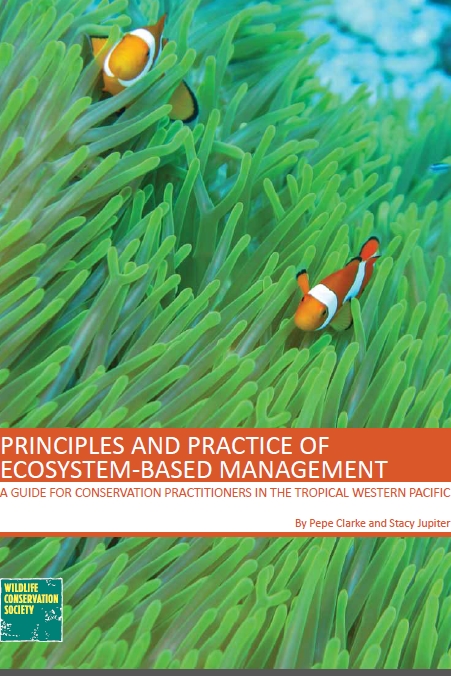
PRINCIPLES AND PRACTICE OF ECOSYSTEM-BASED MANAGEMENT
A GUIDE FOR CONSERVATION PRACTITIONERS IN THE TROPICAL WESTERN PACIFIC
By Pepe Clarke and Stacy Jupiter
Contributors: (in alphabetical order) Umai Basilius, Akisi Bolabola, Martin Callow, Akuila Cakacaka, James Comley, William Donaldson, Daniel Egli, Rikki Grober-Dunsmore, Aaron Jenkins, Kinikoto Mailautoka, Semisi Meo, Sanivali Navuku, Sunil Prasad, Christovel Rotinsulu, Opeti Vateiti, Hans Karl Wendt, Joanne Wilson, Naushad Yakub
Foreword
During the past century, human population growth has been explosive, and increasing rates of environmental modification from human activities have been largely unchecked. Global population has increased nearly 4-fold since 1900 and is predicted to reach 9 billion by 2050. To support the population boom, humans currently use more than one third of terrestrial primary production and over half of accessible freshwater runoff. Soil loss rates, amplified by land clearing for agriculture and development, are more than 10 times greater than rates of soil formation. Atmospheric increases of CO2, driven principally by fossil fuel combustion and habitat conversion, will account for more than half of the anticipated global warming expected this century. The removal of top predators has destroyed entire trophic levels thereby further reducing ecosystem resistance and resilience to change. Consequently, there has never been a greater need or a more appropriate time to focus on holistic management of ecosystems in order to preserve their ecosystem services.
Vulnerability to global change is particularly acute in the tropical Western Pacific. Low lying islands scattered across the Pacific will be some of the first regions on Earth to be severely affected by sea level rise. Deforestation has accelerated throughout the Pacific, endangering terrestrial biodiversity. The tight linkages between terrestrial and marine ecosystems on these small islands leads to degradation of freshwater and marine resources. In addition, access to global markets has elevated fishing pressure, which leads to degradation of coral reefs and threatening local lifestyles and livelihoods.
Ecosystem-Based Management (EBM) has emerged as a viable approach that integrates institutions and people across multiple sectors to collectively manage and protect biodiversity and natural resources. While many handbooks and tools have been developed for implementation of EBM in temperate, developed regions, there has been a distinct lack of guidance for implementing EBM tailored to the specific needs of the tropical Western Pacific. This guide is therefore unique in describing the approaches to EBM that are appropriate for Western Pacific
cultural, socioeconomic, biological and governance contexts. As illustrated in these pages, EBM principles are already enabling communities in the tropical Western Pacific to adapt and respond to global and local environmental changes, thus improving the resilience of their communities. It is our hope that this guide will help more governments, communities and conservation practitioners throughout the region and elsewhere to incorporate the principles of EBM into their management practices. Through the use of these holistic principles, we can help reverse the tide of degradation, thus protecting human health and livelihoods for future generations.
Copyright: © 2010 Wildlife Conservation Society
Reproduction of this publication for educational or other non-commercial purposes is authorized without prior written permission from the copyright holder provided that the source is fully acknowledged. Reproduction of this publication for resale or other commercial purposes is prohibited without prior written consent of the copyright owner.
Citation: Clarke P and Jupiter S (2010) Principles and Practice of Ecosystem-Based Management: A Guide for Conservation
Practitioners in the Tropical Western Pacific. Wildlife Conservation Society. Suva, Fiji.
Lead authors: Pepe Clarke and Stacy Jupiter
Contributors: (in alphabetical order) Umai Basilius, Akisi Bolabola, Martin Callow, Akuila Cakacaka, James Comley, William
Donaldson, Daniel Egli, Rikki Grober-Dunsmore, Aaron Jenkins, Kinikoto Mailautoka, Semisi Meo, Sanivali Navuku, Sunil Prasad,
Christovel Rotinsulu, Opeti Vateiti, Hans Karl Wendt, Joanne Wilson, Naushad Yakub
Cover image: Fraser Hartley
ISBN:978-982-9120-02-1
Available from:
Wildlife Conservation Society (WCS)
11 Ma'afu Street, Suva, Fiji Islands
Tel: +679 331 5174
Also available online at www.wcs.org/EBMguide
The views expressed in this publication do not necessarily reflect the views of the Wildlife Conservation Society.
Wildlife Conservation Society
2300 Southern Boulevard
Bronx, NY 10460 USA


































